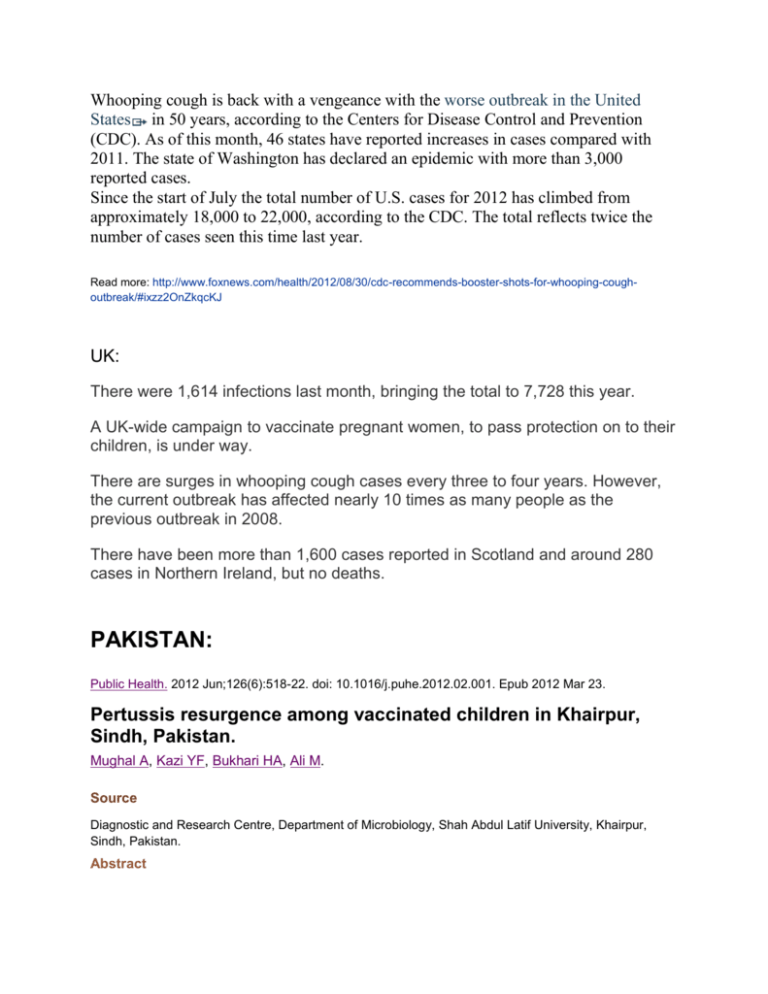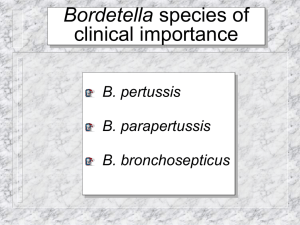
Whooping cough is back with a vengeance with the worse outbreak in the United
States in 50 years, according to the Centers for Disease Control and Prevention
(CDC). As of this month, 46 states have reported increases in cases compared with
2011. The state of Washington has declared an epidemic with more than 3,000
reported cases.
Since the start of July the total number of U.S. cases for 2012 has climbed from
approximately 18,000 to 22,000, according to the CDC. The total reflects twice the
number of cases seen this time last year.
Read more: http://www.foxnews.com/health/2012/08/30/cdc-recommends-booster-shots-for-whooping-coughoutbreak/#ixzz2OnZkqcKJ
UK:
There were 1,614 infections last month, bringing the total to 7,728 this year.
A UK-wide campaign to vaccinate pregnant women, to pass protection on to their
children, is under way.
There are surges in whooping cough cases every three to four years. However,
the current outbreak has affected nearly 10 times as many people as the
previous outbreak in 2008.
There have been more than 1,600 cases reported in Scotland and around 280
cases in Northern Ireland, but no deaths.
PAKISTAN:
Public Health. 2012 Jun;126(6):518-22. doi: 10.1016/j.puhe.2012.02.001. Epub 2012 Mar 23.
Pertussis resurgence among vaccinated children in Khairpur,
Sindh, Pakistan.
Mughal A, Kazi YF, Bukhari HA, Ali M.
Source
Diagnostic and Research Centre, Department of Microbiology, Shah Abdul Latif University, Khairpur,
Sindh, Pakistan.
Abstract
OBJECTIVES:
To investigate the aetiology of persistent cough among vaccinated children as suspected cases
of pertussis in Khairpur District, Sindh, Pakistan. Pertussis or whooping cough, caused by
Bordetella pertussis, is re-appearing in many countries despite vaccination coverage. In Khairpur,
persistent cough and symptoms similar to pertussis among vaccinated children are common but the
aetiology has not been investigated previously.
STUDY DESIGN:
B. pertussis was isolated from cough samples of suspected pertussis patients (n = 700) using
the cough plate method with charcoal agar.
METHODS:
Isolation and confirmation of the clinical isolates of B. pertussis was performed by culture on BordetGengou medium, biochemical tests and polymerase chain reaction.
RESULTS:
In total, 22 strains of B. pertussis were isolated from clinical cough samples.
CONCLUSION:
To the authors' knowledge, this is the first report of the presence of pertussis in vaccinated children in
Khairpur. There is a need for continuous monitoring of pertussis after immunization programmes in order
to assess the efficacy of pertussis vaccination.
Copyright © 2012 The Royal Society for Public Health. Published by Elsevier Ltd. All rights reserved.
Whooping cough found in vaccinated children in Pakistan
Faisal Raza Khan
1 May 2012 | EN
[ISLAMABAD] Health researchers say they have identified whooping cough in children who
had previously been vaccinated against the potentially life-threatening disease in Pakistan's
Sindh province.
Writing in the journal Public Health (23 March) [1], the researchers say their discovery suggests
new work is needed to tailor vaccines and immunisation programmes to whooping cough
strains unique to Pakistan.
The researchers, from Shah Abdul Latif University in Sindh, and COMSATS Institute of
Information Technology in Islamabad, studied 700 children in southeastern Sindh, who —
despite having previously been vaccinated — were suspected of being infected with Bordetella
pertussis, the bacteria that causes whooping cough.
They took samples from 22 children aged from six months to seven years who had "cough-like"
symptoms.
Detailed culture and molecular tests confirmed that the 22 children were infected with the
bacterium. The study noted that the infection rate could have been higher as not all 700 children
were subject to the same analysis.
The study was unable to identify a specific reason for the re-emergence, but said it could be the
result of genetic differences between circulating strains and strains used to make the vaccines, a
problem that has been observed elsewhere in the world.
It also found an overwhelming majority of Pakistani health professionals were unaware that
vaccinated adults can sometimes be reservoirs of lingering bacteria, which they can pass to
childen by coughing.
"Present immunisation practices may not be sufficient in protecting infants and children under
five years of age against pertussis," the report concluded.
It also suggested giving children a booster shot at the age of four – a practice common in
European countries facing similar challenges with vaccine efficacy.
But officials at Pakistan's National Institute of Health (NIH), which operates under the Ministry
of Health, have rejected the findings.
NIH executive director Berjees Mazher Kazi told SciDev.Net that other factors might be reducing
the effectiveness of immunisation programmes, including a child's immune status, general
hygiene conditions, and poor vaccine transport and storage facilities.
Whooping cough commonly occurs in early infancy and accounts for 300,000 deaths per year,
mostly among unvaccinated babies. It remains in circulation round the year.
Outbreaks can be triggered by changing weather conditions, Syed Habib Bukhari, associate
professor of biosciences at CIIT, and a co-author of the study, told SciDev.Net, adding that the
disease is often not diagnosed, and is therefore widely unreported in Pakistan.
An earlier study by Bukhari's team focused on another strain of the disease, B parapertussis,
which was also found in vaccinated children.
That study, published in December 2010 [2], found that the vaccine used in Pakistan protects
against B pertussis, but offers less protection against B. parapertussis.
The 2010 study recommended further research to confirm the findings, and notes that this may
provide evidence for the introduction of vaccines to protect against all strains found in Pakistan.
Link to abstract in Federation of European Microbiological Societies (FEMS) Immunology and
Medical Microbiology
REFERENCES
[1] Public Health (26 March 2012) DOI:10.1016/j.puhe.2012.02.001
[2] FEMS Immunology & Medical Microbiology, Vol 63, Issue 3 (December 2011) DOI:
10.1111/j.1574-695X.2011.00861.x
J. A. Englund, F. M. Munoz. (2013) It Takes an Epidemic to Move a Village: Severe Pertussis
Disease in Infants in the 21st Century. Journal of the Pediatric Infectious Diseases Society
FEMS Immunol Med Microbiol. 2011 Dec;63(3):373-80.
Molecular typing of Bordetella parapertussis isolates circulating i
n Pakistan.
Bokhari H, Said F, Syed MA, Mughal A, Kazi YF, Kallonen T, He Q, King AJ, Heuvelman
K, Mooi FR.
Source
Department of Microbiology, COMSATS Institute of Information Technology, Islamabad, Pakistan.
habib@comsats.edu.pk
Abstract
Although a whole-cell pertussis vaccine was introduced in Pakistan in 1980, little is known about the
pertussis prevalence and circulating strains in Pakistan. The aim of this study was to
analyze Bordetella parapertussis isolates circulating between 2005 and 2009 in Pakistan and to compare
them with those found in other countries during different periods. A total of 59 (7.35%)
B. parapertussis isolates from 802 subjects (median age, 3 years) from Pakistan, with pertussis-like
symptoms were investigated. We carried out genotyping and DNA microarray analyses on
these isolates and compared them with some international isolates of B. parapertussis. We found that the
allele for pertactin (prn) found in strains studied from Pakistan was identical to the predominant type
found in Europe. We showed that B. parapertussis isolates circulating in Pakistan are part of the same
pulsed-field gel electrophoresis group to those circulating in Finland during the period of 1982-2007.
Finally, microarray analysis confirmed that the isolates collected in Pakistan, were quite similar to
international strains. Overall, these results confirm that B. parapertussis is extremely monomorphic. The
high isolation rate of B. parapertussis (7.35%) compared to Bordetella pertussis (0.5%) may suggest that
the whole-cell vaccine used in Pakistan is effective against B. pertussis (0.5% infections detected), but
much less so against B. parapertussis.










